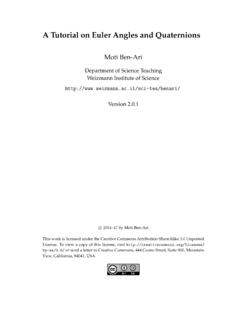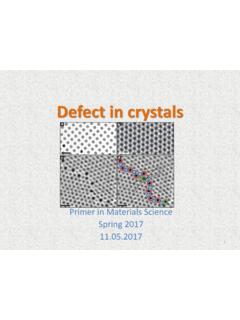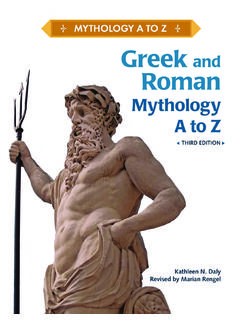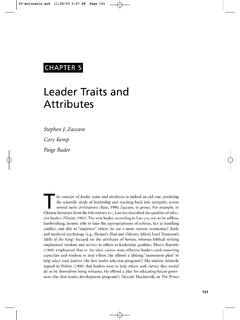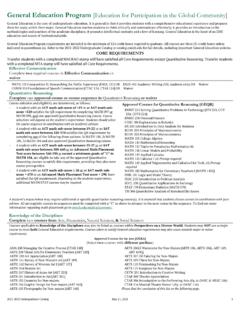Transcription of The Alkaloids - Weizmann Institute of Science
1 The AlkaloidsAlkaloids in the skin glands of poison frogs: A chemical defense against predationWhat are Alkaloids ? Low molecular weight Nitrogenouscompounds 20% of plant species have been found tocontain them Mainly involved in plant defense againstherbivores and pathogens Utilization by human3000 Year History of Alkaloids use by Humans In most human history, Alkaloids from plant extracts have been used as ingredients in potions (liquid medicine) and poisons Ancient people used plant extracts containing Alkaloids for treating a large number of ailments including: snakebite, fever and insanity3000 Year History of Alkaloids use by HumansIn the middle east-the latex of Opium Poppy (Papaver) was already used at 1200 of Opium Poppy (Papaver)Maturing capsuleOpium Poppy capsule Capsule releasing latex when wounded Latex contains the Alkaloids morphine and related Alkaloids such as codeine 1200 BC in GreeceAlkaloids of Opium Poppy (Papaver)Bufo marinusfrog accumulates high amount of morphine in its skinLater the use of Alkaloids Spread to the West-The piperidine alkaloid coniine (the first alkaloid to be synthesized)-Coniine is extremely toxic, causing paralysis of motor nerve endings-"The death of Socrates"-the philosopher Socrates drank and extract of coniine-containing hemlock (339 )Jacques Louis David painting (1787)In Egypt-Queen Cleopatra used extracts of henbane (Hyoscymus) to expand her pupils and appear more attractive to her male political competitorsAlkaloids of Opium Poppy (Papaver)
2 Theriak, a mixture of opium, dried snake meat and wine One of the oldest and long lived medications in the history of mankind Against spiders, scorpions and snakesAlkaloids of Opium Poppy (Papaver) Morphine named for Morpheus, the god of dreams in the Greek mythology Friedrich Serturner isolated Morphine at 1806 and this gave rise to the study of Alkaloids In 1819, Carl Meissner (Halle) gave the name Alkaloids after the plant al-qalifrom which soda was isolated (sodiumcarbonate called alkaliin arabic) Alkaloids first defined as pharmacologically active nitrogen containing basic compounds of plant origin (nowadays expanded) Alkaloids are not Unique to Plants Alkaloid bearing species have been found in nearly all classes of organisms: frogs, ants, butterflies, bacteria, sponges, fungi, spiders, beetles and mammals Not always synthesized de novo in the organisms but rather taken up Some animals, such as frogs produce toxic Alkaloids in the skin or secretory glands Insects, use plant Alkaloids as a source of attractants, pheromones and defense substances Alkaloids in Modern MedicineAtropine-antidote to nerve gas poisoningAlkaloids in Modern MedicineCodeine, Morphine, -Analgesic (painkiller) Alkaloids in Modern MedicineCaffeine-central nerve system stimulantAlkaloids in Modern MedicineQuinine-antimalarial, facilitated exploration of the tropics-A monoterpenoid indole alkaloid-Prepared from the bark ofAlkaloids in Modern MedicineSanguinarine-Antibacterial showing antiplaque activity, used in toothpastes and oral rinsesAlkaloids and Geopolitics-The Opium Wars(Anglo-Chinese wars) between China and Britain (1839-1859)
3 -Due to a trade deficit Britain had to start using silver for the trade with India (in exchange for silk, porcelain and tea)-The Brits started smuggling Opiumfrom British India into China to reduce the amount of silver they exchange -China lost in both warsAlkaloids and Geopolitics-China forced to tolerate the opium trade and sign unequal treaties opening several ports to foreign trade and giving Hong Kong to Britain-Several countries followed Britain and forced unequal terms of trade onto China. This foreign influence led to the downfall of the Qing dynesty (1911) Alkaloids and Geopolitics-Efforts underway to eradicate production of the semisynthetic compound HEROIN (derived by acetylation of Morphine)-Also eradication of Cocaine, a natural alkaloid from the coca plantThe Role of Alkaloids in Plants? Since the discovery of Morphine 12,000 Alkaloids isolated Alkaloids as other secondarymetabolites are produced in a unique pattern Large investment in nitrogen-it is clear that they have an eco-chemical roleAlkaloids and Plants Chemical Defense-Wide range of physiological effects on animals-Antibiotic activity-Toxic to insects-Feeding deterrents-Example-NICOTINE from Tobacco, one of the first insecticides and is most effective-Herbivory induces Nicotine formation in TobaccoAlkaloids and Plants Chemical Defense-Caffeinealso an effective insect toxin-Found in leaves and beans of Cocoa, Coffee, cola, mate', and tea-Caffeinewill kill larvaeof the Tobacco horn-worm (Manduca sexta)
4 Within 24 hours in dietary concentration present, below those found in fresh coffee beans or tea leavesInhibits the phosphodiesterase thathydrolyzes c-AMPA lkaloids and Plants Chemical Defense-Alpha-solanine, a steroid alklaoid is a cholinesterase inhibitor found in potato tuber-Teratogenicity/embryotoxicity of sprouting potatoes Alkaloids and Plants Chemical DefensePyrrolizidine alkaloid-toxic to mammals (family asteraceae)Quinolizidine alkaloid (occur in the Lupinus genus)-Lupanine is a bitter compound, feeding deterrentAlkaloid BiosynthesisAlkaloid Biosynthesis Alkaloids in most cases are formed from L-amino acids Tryptophan, tyrosine, phenylalanine, lysine and arginine as precursors Produced alone from the above precursors or in combination with other chemicals such as terpenoid moieties One or two transformations can covert the above amino acid precursors to very specific secondary metabolitesAlkaloid Classes Terpenoid IndoleAlkaloids BenzylisoquinolineAlkaloids TropaneAlkaloids PurineAlkaloids Pyrrolizidine Alkaloids Other Alkaloids : Quinolizine, Steroidal glycoalkaloids, Terpenoid Indole Alkaloids Large group of about 3,000 compounds Indole moiety provided by Tryptamine (derived from Tryptophan) and a Terpenoid component Moneterpenenoid indole alkaloid:the iridoid glycoside secologanin (derived from the monoterpene Geraniol) and TryptamineMonoterpenoidIndole Alkaloids (1800 known) Ajmaline.
5 The first alkaloid for which biosynthesis was clarified at the enzyme levels+MonoterpenoidIndole Alkaloids Antiarrythmic (suppresses heart rythnus) that functions by inhibiting glucose uptake by heart tissue mitochondriaMonoterpenoidIndole AlkaloidsMadagascar periwinkle (Catharanthus roseus/ vinka) Terpenoid Indole AlkaloidsCatharanthus Vinblastine and VincristineCatharanthus Vinblastine and Vincristine Both compounds commonly used for cancer therapy Bind microtubules and inhibit hydrolysis of GTP and thus arresting cell division at metaphase Bind Tubulin at different domains compared to Colchicines Also inhibit protein, nucleic acids and lipid biosynthesis Catharanthus Vinblastine and Vincristine Reduce protein kinase C that modulates cell growth and differentiation Vinblastine is a component of chemotherapy for metastatic testicular cancer, Hodgkins desease and other lymphomas Vincristine is the prefferd treatment for acute leukemia in children Both drugs expensive, catharanthus the only source (low levels)
6 Catharanthus Terpenoid Indole AlkaloidsExample of metabolism in multiple type of tissues coupled to metabolism in different subcellular compartmentsCatharanthus Terpenoid Indole AlkaloidsFacchini & St-Pierre, 2005 Subcelluar location of metabolismcytosolvacuoleER membraneouter ERchloroplastCatharanthus Terpenoid Indole AlkaloidsMetabolism of Monoterpenoid Indole Alkaloids in Three Different Catharanthus Cell types Extensive subcellular trafficking of pathway intermediates Geraniol 10-hydroxylase: internal phloem parenchyma of aerial organs Tryptophan decarboxylase (TDC), Secologanin synthase (SLS) and Strictosidine synthase (STR) to epidermis of aerial organs and the apical meristems of rootsMetabolism of Monoterpenoid Indole Alkaloids in Three Different Catharanthus Cell types Deacetylvindolineacetyltransferase (DAT) and desacetoxyvindoline 4-hydroxylase (D4H) to the laticifers and idioblasts of leaves and stems Vindoline pathway intermediates must be translocated between cell typesMetabolism of Monoterpenoid Indole Alkaloids in Three Different Catharanthus Cell typesKutchan, 2005 Regulation of Monoterpenoid Indole Alkaloids in CatharanthusORCA-Octadecanoid Responsive Cartharanthus AP2/ERF domain proteinRegulation of Monoterpenoid Indole Alkaloids in CatharanthusActivation tagging in Catharanthus cell cultures.
7 Screen on toxic 4-methyl tryptophan (TDC can detoxify it)Regulation of Monoterpenoid Indole Alkaloids in CatharanthusGantet & Memlink, 2002 ORCA3 can activate promoters of both primary and secondary metabolic pathways in the TIA pathway of CatharanthusRegulation of Monoterpenoid Indole Alkaloids in CatharanthusOther Factors InvolvedActivatorRepressorGantet & Memlink, 2002 Regulation of the TIA Pathway in Catharanthus (autoacivation of ORCAs) Endt et al, 2002 Regulation of Terpenoid Indole Alkaloids in CatharanthusGantet & Memlink, 2002 Regulation of Monoterpenoid Indole Alkaloids in Catharanthus by JasmonateRegulation of Monoterpenoid Indole Alkaloids in Catharanthus by Jasmonate-Plants lack an immune system (as in animals), but possess mechanisms that recognize potential pathogens and initiate defense responses -Various types of oxygenated fatty acids, termed oxylipins or octadecanoids , are involved in responses to physical damage by animals or insects, stress and attack by pathogensRegulation of Monoterpenoid Indole Alkaloids in Catharanthus by Jasmonate-These compounds are similar to the eicosanoids derived from arachidonate in animals (important in the inflammatory process) -Oxylipins are derived from linoleic and -linolenic acids with a first key step being the action of lipoxygenases (LOX)
8 -Such compounds are highly reactive, and quickly metabolized by various enzymes into series of oxylipins, including Jasmonates with a range of distinct of Monoterpenoid Indole Alkaloids in Catharanthus by JasmonateRegulation of Monoterpenoid Indole Alkaloids in Catharanthus by JasmonateORCA3and other genes induced by JasmonateORCAs act in aJasmonic Acid Dependant Elicitor Signal Transduction PathwayMemlink et al, 2001-Elicitor(any compound inducing a plant defense reaction (either from microorganism, plant and abiotic such as heavy metals)-Protein phosphorylationand calcium effluxare required for elicitor induced Jasmonate biosynthesis-CrBF-1acts in a signal transduction pathway independent of Jasmonic acid(Oxylipin)Plant Secondary Metabolites Induced by JasmonatesBenzylisoquinoline Alkaloids A large and diverse class present in a range of plant families The first biosynthetic step is decarboxylation of Tyrosine by Tyrosine Decarboxylase (TYDC) to form TyramineBenzylisoquinoline Alkaloids Coupling of two Tyramine derivatives yields (S)-Norcoclaurine Norcoclaurineis the precursor of several thousand benzylquinoline alkaloidsTyrosine-TyramineTyrosine-L-DOP A(phenol oxidase)DOPA decarboxylasePhenol oxidaseTyrosine-p-Hydroxy-phenylpyruvate (transaminase)DecarboxylaseBenzylisoquin oline AlkaloidsA series of methylation and oxidation reactions yield the branch point intermediate of BIA biosynthesis, (S)-ReticulineBenzylisoquinoline Alkaloids (S)-Reticulin.)
9 The Chemical Cameleon(twisted and turned before being oxidized to generate different structures)Benzylisoquinoline AlkaloidsMorphine and Codeine biosynthesis in Opium PoppyMorphine and Codeine Biosynthesis in Opium Poppy-After 190 years since its discovery the characterization of the enzymes is nearly complete-Genes cloned but not all the pathway Morphine and Codeine Biosynthesis in Opium Poppy (cell localization)Benzylisoquinoline AlkaloidsBiosynthesis of BERBERINEB enzylisoquinoline AlkaloidsBiosynthesis of BERBERINE-A pigment with bright yellow color-Native American used to dye cloth, reduce inflammation, stimulate digestion, treat infections and induce abortionsBenzylisoquinoline AlkaloidsBiosynthesis of BERBERINE-A major alkaloid in Goldenseal (Hydrastis canadensis)-Used to prevent colds and flu-The third most popular herbal in the USBiosynthesis of BERBERINE (Berberine bridge enzyme)Benzylisoquinoline Alkaloids -The enzyme possesses a covalently attached FAD moiety, which is essential for catalysis-The reaction involves the oxidation of the N-methyl group of the substrate (S)-reticuline by the enzyme-bound flavin and concomitant formation of a carbon-carbon bond (the "bridge") Tropane Alkaloids -Plants containing these Alkaloids have been used throughout history as poisons, but many of the Alkaloids do have valuable pharmaceutical properties-Known to be present in the Solanaceaefamily-The TA Cocainewas found in very small amounts in the original Coca-Cola formula, but was not the main concern of the USDA at the time.
10 Caffeine was considered to be the major problem with the drink. Tropane AlkaloidsCocaineTropane Alkaloids -Datura-Datura, a rich source of scopolamine and hyoscyamine used as a sedative-Scopolamine can cause death in infantsScopolamineTropane Alkaloids -Biosynthesis-Methylation of putrescine is the start point for biosynthesisTropane Alkaloids -BiosynthesisA pyridine alkaloidPurine Alkaloids -Caffeine the most important example-In, coffee, tea, mate', cacao, camellia-Purin alkaloid biosynthesis starts with xanthosine, a nucleotide degradation productPurine Alkaloids -Caffeine BiosynthesisPyrrolizidine Alkaloids -The leading plant toxins-Over 360 different structures, found in 3% of the world flowering plants-Primarily restricted to; Boraginaceae, Asteraceae, Fabaceae, and Orchidaceae-Most of them are esters of basic alcohols known as necine basesPyrrolizidine Alkaloids -Mostly derived from either the polyamines putrescine and spermidine Pyrrolizidine AlkaloidsA necine basePyrrolizidine Alkaloids -Jacobine and others from Senecio jacobaeJacobine occurs in flowersOther AlkaloidsOther Alkaloids --BetalainsBetalainsRed Pitaya ( , BGU)Antioxidants, stable in heat, stable in pH 3 and 7, different colors (bogonvilia, portulaca, celosia, red beet, sabres).



